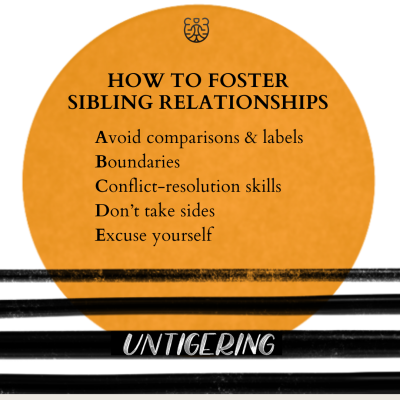The other day at dinner, NoNo was complaining that he wasn’t feeling well.
“My stomach hurts,” he moaned.
My partner and I started peppering him with questions to try to figure out what might have upset his stomach. “What did you eat? Did you have cold or spicy foods? Was there dairy in your lunch?”
NoNo’s younger brother took a different approach, however.
“Would you like a hug?” KK offered.
NoNo paused slightly, then answered, “OK, I’ll take a hug.”
Cue my heart melting as I watched my 11 and 13 year old embrace each other.
It was so sweet of KK to offer comfort and affection, and sweet of NoNo to not be too “cool” to accept.
I’m grateful that my boys have such a great relationship with each other. That’s not to say that they never have conflict, but I’d say that they know how to love well and how to fight well.
There’s never a guarantee that our children will get along with each other, but here are a few ABCs that can help us to foster loving sibling relationships.

Avoid Comparison and Labels
- “Look at how nicely your sister is sitting!”
- “Sam’s the quiet one. Lucas is the wild child.”
- “Let’s see who can clean their room the fastest!”
It’s easy to compare and label our children, but when we make comments like the ones above we end up pitting them against each other. They feel like they must compete for our attention, affection, and affirmation. They don’t feel accepted for who they are but must outperform their siblings in order to be loved. One may be held up as the model child that the others must emulate. While this may result in outward compliance and obedience, it also fosters resentment and rivalry. Avoid creating that dynamic of comparison and competition.
Boundaries
Create a culture of consent and help them to respect each other’s boundaries. That means we sometimes have to step in and enforce the boundary so that they learn to listen to–rather than bulldoze over–their sibling.
- “Do you like it when he does that? You can tell him to stop.”
- “Did you hear that she told you to stop? She looks upset. Do you need help stopping?”
- “I heard him say that he wasn’t done playing with the unicorn. Please give it back until he’s ready. Come on, I’ll play blocks with you.
Teach them that “no” means no and “yes” means yes. And there’s always “wait” or “maybe” or “later” too! Model how to communicate boundaries and expect them to be honored.
Conflict-Resolution Skills
- “Maybe you need a little break from each other?”
- “How did that make you feel when he didn’t include you in the game?”
- “You both want to choose a video to watch. How can we solve the problem together?”
Model and empower your children with the skills they need to resolve conflict well.
- Attuning to their bodies and emotions
- Emotional regulation
- The ability to communicate their needs, desires, feelings, and boundaries
- Empathy for the other person
- Collaborative problem-solving
Don’t Take Sides
Avoid comments like:
- “Can you please be nice to your sister for once?”
- “Stop poking him! Go to your room!”
- “OK, who started it?!”
There is no need to play the referee (deciding who is right or wrong and meting out punishment to the offending party). Instead, we can be the sportscaster (observing what we see happening in a non-judgmental manner). When we stop taking sides or playing favorites, they can focus on working out their problems rather than arguing their case to Mom or Dad.
Excuse Yourself
Know when you need to intervene and when you just need to hang back and let them work things out. When they’re younger they’ll need more support and guidance, but as they get older we can give them room to practice how to manage conflict on their own. Resist micromanaging, forcing reconciliation, apologies, or forgiveness, or rushing them through the process because we’re afraid of any conflict. That may mean we sometimes have to remove ourselves from the situation so that we’re not triggered and tempted to shut them down, control, or interrupt them. Or we can stay nearby but stay out of it, only stepping in if things start getting out of hand.
We can learn to:
- Sit with the Tension – Normalize conflict and upset feelings. It’s part of being human!
- Sit with Attention – Notice your own triggers and feelings. Observe what’s happening between your children instead of simply reacting.
- Sit with Intention – Discern whether you need to intervene and decide how you will respond. Not every conflict needs to be addressed in the moment… or at all.
(My partner, Jason, wanted credit for this bullet list.)
What else would you add? What other nuggets of wisdom about sibling relationships can you share? What sibling challenges are you facing right now?
Comment below!


One Response
These are perfect parenting articles for me